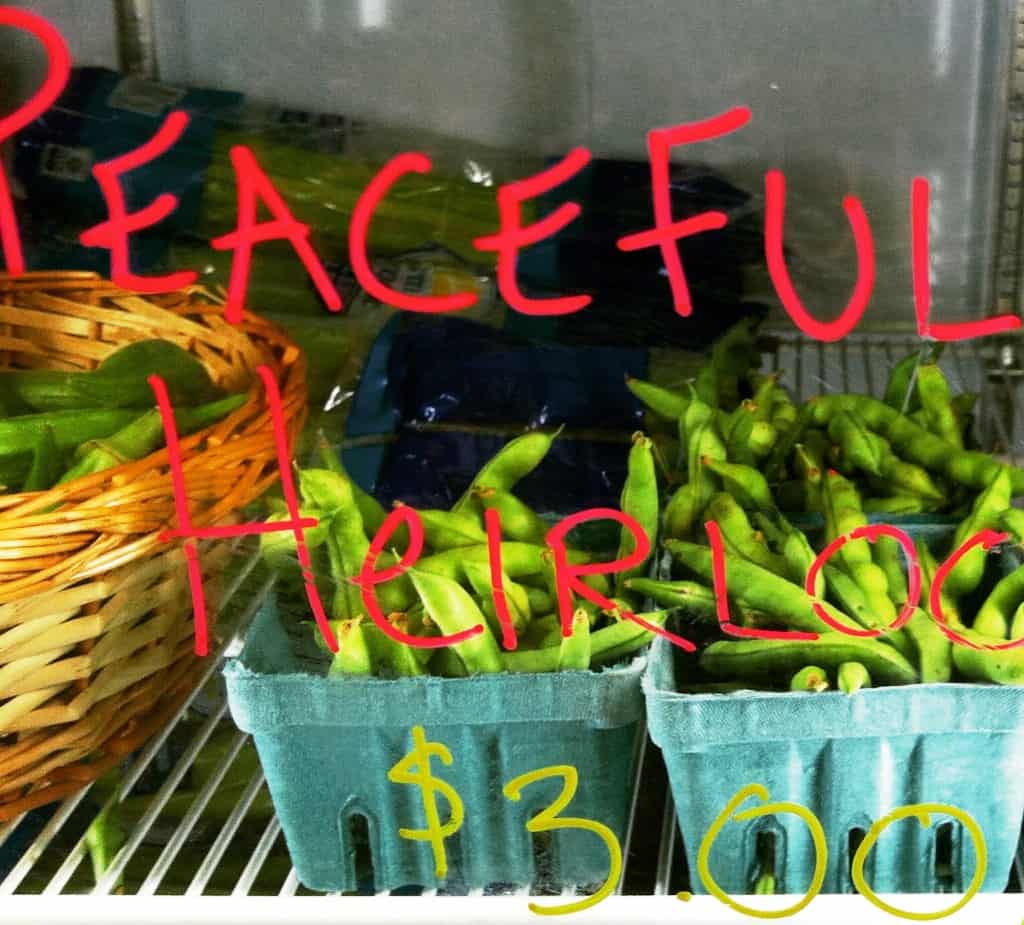Heirlooms, Veggie lore, local Joys, and Telling Stories

It’s not easy to let go of our often-frustrated attachment to perfection, but heirloom produce can help. Heirloom produce, like comedy, is not pretty. Someone wrote that heirlooms have made “ugly” a good thing—many of us eagerly collect offerings of lumpy, scarred, multi-colored tomatoes, potatoes, eggplant and more for higher prices because we love their taste and we delight in their differences. Without them, we may believe that all such produce is the same. (Our chefs use these amazing heirloom tomatoes in their Mozzarella Caprese Stack, a beautiful pesto-pooled, balsamic-drizzled stack of these wide, ripe tomato slices interleaved with fresh mozzarella and topped with fresh basil.)
Heirlooms are trendy now, but we the people are fickle about which objects or products are worthy of our attention, time, and dollars. Trends change as we do, and our patterns through time can be defined. News is made about how millennials are not as attached to handling and preserving family heirlooms as previous generations were, though they are attracted to “vintage.” Look up how the words antiques, collectibles, vintage, even retro are used, and you’ll find lots of Q&A, but mostly, if you’re like me, you’ll see how we use words and buy things without thinking much beyond the wavy layers of marketing buzz. Heirloom plants have names and histories, roots, just as we do. They tell stories.
I’ve read that three things set heirloom produce apart from commercially grown plants: age, pollination, and quality. It seems to me that these traits are irreplaceable in people too. With age and experience can come wisdom; with a community comes the pollination of ideas and the support of every level of our human growth and sharing; and the quality of our continuing community life depends upon such love and nourishment. Harvest and healing happen. This is also where good food comes in.
We’re happy to have some local heirloom produce on our menu and in the store, like our Brandywines from Larry and Lee Newlin’s Peaceful River Farm in Chapel Hill — sunburst yellow on top and orange red with their typically very large fruit. Larry also passed on some veggie lore. Craig LeHoullier, the Cary author of Epic Tomatoes and a renowned expert on heirlooms, has Cherokee Purple in his top 6 list for taste and reliability and named it after being given the seed from a Tennessee man as a passalong plant that had been given to a neighbor’s ancestor a century ago by the Cherokees. Brandywine is on his top 6 list as well (he’s tasted more than 3,000 varieties), and LeHoullier says it is the heirloom that other heirlooms are judged against for its rich taste.
Larry also brought McMain Greasy Cut-Short beans (also for sale in our produce section!). The Cut-Shorts are from the Mountain Sustainable Agriculture Center in Berea, KY which is directed by Billy Best, a retired administrator who travels the Appalachians discovering passalong beans and their stories. He’s a proponent that heirlooms have not had their taste and nutrition bred out of them to travel to faraway grocery stores and restaurants and to have a more “attractive” and uniform appearance on a shelf. Greasy cut-shorts are among the most desired green bean by chefs due to their rich taste and high protein content. They are “greasy” because of their shine and cut-short because the beans pack together tightly and push the hull. “Stringing and breaking” beans take more time to prepare and cook, but isn’t taste sometimes worthy of a convenience sacrifice? Just ask your grandparents or other older relatives or neighbors and you’ll get a story about porch-sitting, sharing, and the satisfaction of beans. I guarantee it will bring a smile to your face.
Listening to stories, and questioning and exploring the images, beliefs, and lifestyles that have been the foundation of our culture is a worthy pursuit, and the Newlins and Peaceful River Farm are a wonderful example of conscious and energetic stewardship of what life offers us and the joy of using our gifts. Their efforts are as much a celebration of life as they are a source of nourishment.
The Newlins like to say that they’re not from here, but they’ve come home. Larry’s roots run deep in Saxapahaw and its surrounds. Every day they say they feel the presence and influence of those who came before. Larry agrees with author, poet, and farmer Wendell Berry: “What I stand for is what I stand on.” The Newlins’ invitation is to join them: “Wellness doesn’t just fall from the sky. The deliberate choices we make can create a vibrant and energy-filled existence. We all need motivation, inspiration, and information to broaden and deepen our commitment to obtaining optimum health. The key is in discovering and trying healthy, delicious foods that taste great for the whole family. We have to change our relationship with food as it is more about what we gain health-wise than what we give up! There really is a deep joy in healthy cooking. Plus it’s fun!”
Look for Peaceful River lima beans soon! Visit their web site to learn more about their sustainable produce, edible flowers, recipes, classes, and dinners. You will be inspired!
Thank you, Peaceful River, T5 Farm, Turtle Run, Haw River Mushrooms, Reverence Farm, Cane Creek Farm, Braeburn Farm, and many more, for all you do! Here at The Saxapahaw General Store, we salute all it takes to feed ourselves and each other well as we strive for a culture of love, joyful service and extravagant welcome. With your help, we’re getting ourselves back to the Garden.nc
#saxgen #heirloom #lovelocal #thankafarmer #buylocal #ilovebeans #peacefulriverfarm #canecreekfarm #braeburnfarm #T5Farm #HawRiverMushrooms #ReverenceFarm #nc #saxapahaw #chapelhill #epictomatoes #greasys #summertime
